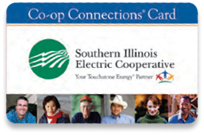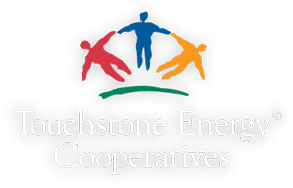INTERCONNECTION AND PARALLEL OPERATION OF DISTRIBUTED GENERATION
I. OBJECTIVE
To establish safety, reliability and economic standards for interconnection and parallel operation of distributed generation of member-owned on-site electric generation facilities using renewable fuel sources designed primarily to offset the member’s electrical requirements.
II. DEFINITIONS
Distributed Generation is defined as any generation built within close proximity to the generating member’s load regardless of generation capacity or energy source of such generation and includes but is not limited to:
A. small scale environmentally friendly generators such as photovoltaics (PV), fuel cells, small wind turbines;
B. microturbines or reciprocating engines fueled by renewable fuels such as landfill gas or methane gas from digesters;
C. any qualifying facility (QF) under the Public Utility Regulatory Policies Act of 1978 (PURPA);
D. any on-site generation with less than 40 kilowatts (hereafter “kW”) of capacity interconnected with distribution facilities;
E. commercial emergency and standby diesel generators installed, for example, in hospitals, hotels and farms;
F. residential standby generators;
G. generators installed by a utility at a substation for voltage support or other reliability purposes.
Cooperative – Southern Illinois Electric Cooperative, an Illinois not for profit corporation.
IEEE Standard 1547 – The Institute of Electrical and Electronic Engineers, Inc. (IEEE) Standard 1547 (2017) “Standard for Interconnecting Distributed Resources with Electric Power Systems”, as amended and supplemented, at the time the interconnection request is submitted.
IEEE Standard 1547.1 – The IEEE Standard 1547.1 (2018) “Conformance Test Procedures for Equipment Interconnecting Distributed Resources with Electric Power Systems”, as amended and supplemented, at the time the interconnection request is submitted.
Nameplate Capacity – The maximum rated output of a generator, prime mover, or other electric power production equipment under specific conditions designated by the manufacturer and is usually indicated on a nameplate physically attached to the power production equipment.
Small Generator Facility – The equipment used by an interconnection member to generate, or store electricity that operates in parallel with the electric distribution system with a Nameplate Capacity of 40 kilowatts (hereafter “kW”) or less. A Small Generator Facility typically includes an electric generator, prime mover, and the interconnection equipment required to safely interconnect with the electric distribution system or local electric power system. These facilities have been approved by a nationally recognized testing laboratory or must have been approved by the Cooperative under a study process and qualify for expedited review.
UL Standard 1741 – Underwriters Laboratories’ standard titled “Inverters Converters, and Controllers for Use in Independent Power Systems”, February 15, 2018, edition, as amended and supplemented.
Witness Test – For lab certified or field approved equipment, verification (either by an on-site observation or review of documents) by the Cooperative that the interconnection installation evaluation required by IEEE Standard 1547 Section 5.3 and the commissioning test required by IEEE Standard 1547 Section 5.4 have been adequately performed. For interconnection equipment that has not been lab certified or field approved, the Witness Test shall also include the verification by the Cooperative of the on-site design tests as required by IEEE Standard 1547 Section 5.1 and verification by the Cooperative of production tests required by IEEE Standard 1547 Section 5.2. All tests verified by the Cooperative are to be performed in accordance with the test procedures specified by IEEE Standard 1547.1.
III. APPLICABILITY
This interconnection policy applies to Cooperative members proposing to install and interconnect Small Generator Facilities that:
A. Have a Nameplate Capacity less than 40 kW;
B. Are not subject to the interconnection requirements of the Independent System Operations and Regional Transmission Organization; and
C. Are designed to operate in parallel with the electric distribution system.
IV. INTERCONNECTION REQUESTS
A. Members seeking to interconnect a Small Generator Facility shall submit an interconnection request using the form attached hereto as Attachment A. The request may be eligible for expedited interconnection review if the request is for a Small Generator Facility using lab certified or field approved interconnection equipment.
B. Interconnection equipment shall be deemed to be lab certified if it is evaluated by a nationally recognized testing laboratory (NRTL) and found to be in compliance with IEEE Standard 1547, including use of IEEE Standard 1547.1 testing protocols to establish conformity, UL Standard 1741 and NFPA 70 National Electrical Code.
C. Interconnection equipment shall be deemed to be field approved if within the previous 36 months of the date of the interconnection request, it has been previously approved for use with the proposed Small Generator Facility in a materially identical system application, and the prior approval process included a successful Witness Test.
D. The member must submit to the Cooperative plans of the proposed installation and must obtain approval for the installation. This approval process will include a review by the Cooperative of the effect of the proposed generation on the Cooperative’s distribution system, including its protective scheme. The member requesting interconnection shall pay the cost of this review. No installation will be permitted that reduces reliability to other members or causes voltage conditions on the system to be outside of the limits of ANSI C84.1 Range A. No installation will be permitted that is expected to produce objectionable harmonics on the system. Any mitigation required to resolve harmonic problems created by a member-owned generator will be completed and paid for by the member.
E. For generating facilities with nameplate ratings of 40 kW or more, the member must comply with Southern Illinois Power Cooperative’s Facilities Connection Requirements.
V. REVIEW
A. The Cooperative shall review the application and evaluate the potential for adverse system impacts. All costs of construction of facilities on the Cooperative’s system to accommodate the Small Generator Facility shall be paid by the member.
B. The Cooperative shall, within 15 business days after receipt of the interconnection request, inform the applicant that the interconnection request is complete or incomplete and if so, what materials are missing.
C. The Cooperative shall, within 15 business days after the end of the 15 business days noted in B. above, verify that the Small Generator Facility equipment can be interconnected safely and reliably.
D. Unless the Cooperative determines and demonstrates that a Small Generator Facility cannot be interconnected safely or reliably to its system and provides a letter to the applicant explaining its reasons for denying an interconnection request, the Cooperative shall approve the interconnection request subject to the following conditions:
-
- The Small Generator Facility has been approved by local or municipal electric code officials with jurisdiction over the interconnections;
- A certificate of completion has been returned to the Cooperative. Completion of local inspections may be designated on inspection forms used by local inspecting authorities;
- The Witness Test has been successfully completed or waived; and
- The applicant has signed a standard small generator interconnection agreement and provided proof applicant has complied with the terms of the agreement. When an applicant does not sign the agreement within 30 business days after receipt from the Cooperative, the interconnection request will be deemed withdrawn unless the applicant requests to have the deadline extended for an additional 30 days (the “Extension”). No further extensions shall be allowed. The request for Extension shall not be denied by the Cooperative.
VI. INSURANCE RECOMMENDATION AND INDEMNIFICATION
It is recommended, but not required that the member consult legal counsel to determine the member’s potential liability resulting from its interconnection to the Cooperative’s facilities, and that any policy issued throughout the term of this agreement, carry a liability insurance policy issued by a licensed insurance carrier with an A.M. Best rating of B+ or better that provides protection against claims for damages resulting from (i) bodily injury, including wrongful death; and (ii) property damage arising out of the member’s ownership and/or operation of the Distributed Generation facility under this agreement. It is recommended that the limits of such policy be at least $1,000,000 per occurrence.
VII. MISCELLANEOUS REQUIREMENTS
A. The Cooperative shall be reimbursed for all costs of interconnection, including all carrying costs, incurred by the Cooperative in connecting the member generation facility to the distribution system. Those costs for interconnection of Small Generator Facilities shall not exceed $500.00 unless the facility fails initial testing and additional review is necessary.
B. The Cooperative shall have free access to the member’s Small Generator Facility and interconnection equipment at all times to monitor operation of the member’s equipment, Cooperative-supplied service equipment connected to such system, or to disconnect if the facility is not in compliance with the requirements of IEEE Standard 1547 and the non-compliance adversely affects the safety or reliability of the electric system. The Cooperative shall, unless an emergency that could affect either the reliability or safety of the Cooperative’s facilities is present, provide reasonable notice to the member prior to disconnection of the facility if possible.
C. The Cooperative shall have the right to inspect and approve all plans for parallel generation systems and the interconnection systems prior to initial operation or subsequent operation following modifications.
D. The member shall make any necessary changes or adjustments to the additional facilities being operated in parallel to eliminate interference on the Cooperative’s distribution system.
E. The member shall not energize the Cooperative’s system during any period of utility service interruption. The member’s equipment must contain a disconnect device to which the Cooperative has access and which the Cooperative can lock in an open position to disconnect, for safety reasons, the member’s electric generating facility from the Cooperative’s electric delivery system.
F. Electric generation facilities may be disconnected by the Cooperative from its system whenever, in the sole opinion of the Cooperative, such action is required by an emergency, for reasons of safety or due to interference with service to other members. The facility shall also be subject to the Cooperative’s requirements for maintaining voltage standards of output and the production of reactive power.
G. Phase, frequency and voltage of the member’s interconnected generation shall be compatible with that provided by the Cooperative.
H. The members shall pay the cost of interconnection as set forth in A above and all initial and future transmission, distribution, metering, service and other facilities costs necessary to permit interconnected operations with the Cooperative.
I. Any auxiliary or reserve power service required by the member must be arranged in accordance with the terms of the Cooperative’s applicable policies/rates as modified from time to time.
ADOPTED: January 28, 2008
Reviewed: June 30, 2014
Amended: February 19, 2015
Amended: January 30, 2017
Amended: May 23, 2022
Amended: February 27, 2023
Downloads:


